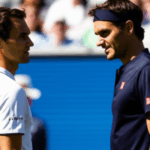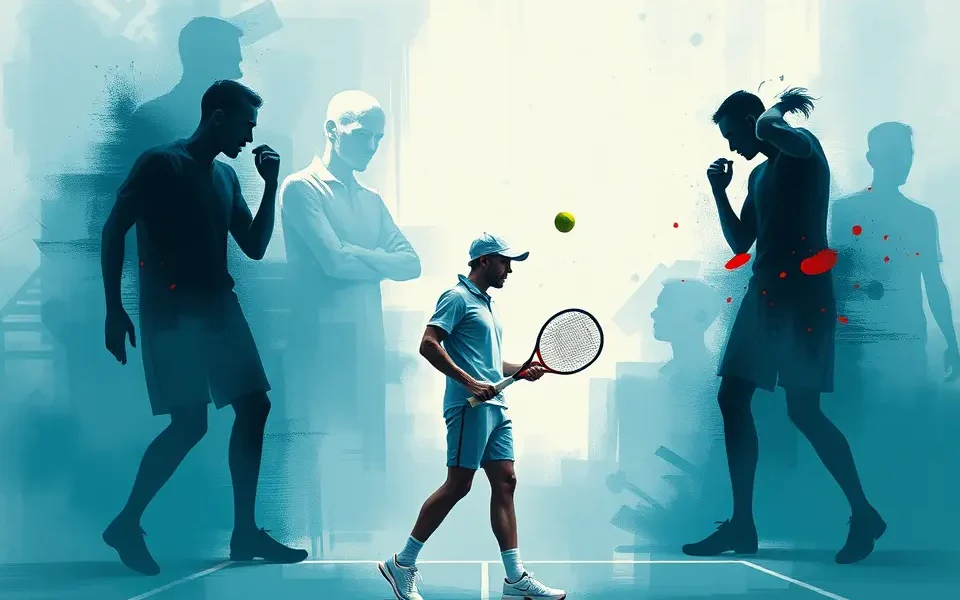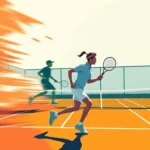Carlos Alcaraz Garfia, the Spanish tennis sensation, has taken the world by storm with his explosive playing style and impressive achievements at a young age. With 18 ATP Tour-level singles titles, including four Grand Slam titles and an Olympic silver medal, he has already etched his name in tennis history. However, despite his remarkable success, tennis experts and analysts have identified areas where the young star can improve. Tim Henman, a former British No. 1, has pointed out a significant weakness in Alcaraz’s game: a psychological vulnerability that can manifest as physical issues under pressure.
Decoding Alcaraz’s Game: Strengths and Style
Alcaraz is known for his aggressive baseline game, characterized by powerful forehands and backhands that push his opponents back and open up the court. His forehand, in particular, is a thing of beauty, often compared to those of Roger Federer and Rafael Nadal. He uses a full unit turn, making it difficult for opponents to read where he will hit the ball. Alcaraz excels at constructing points with his forehand, attacking his opponent’s backhand, and capitalizing on any subpar shots.
Beyond his powerful strokes, Alcaraz possesses exceptional footwork, enabling him to cover the court quickly and efficiently. He is also skilled at the net, displaying great hand skills despite preferring to play from the baseline. His ability to mix up his play, using slices to disrupt his opponents’ rhythm and neutralizing points with chips, adds another dimension to his game.
Alcaraz uses a Babolat Pure Aero VS racket, which complements his playing style by generating significant spin and power. This racket allows him to maintain control while unleashing his natural power. His athleticism is top-notch, providing him with the strength, speed, and endurance to compete with anyone on tour.
Henman’s Analysis: The Mental Game
Tim Henman’s analysis sheds light on a crucial aspect of Alcaraz’s game that goes beyond technical skills and physical prowess. Henman suggests that Alcaraz’s psychological vulnerability can lead to physical problems, particularly in high-pressure situations.
Henman specifically referenced Alcaraz’s experience at the French Open, where he suffered severe cramps during his semi-final match against Novak Djokovic. Henman believes that the cramps were a result of the nervous tension associated with playing against such a formidable opponent. Despite Alcaraz’s excellent physical condition, the mental pressure seemed to take a toll on his body.
The Djokovic Factor: Exposing Weakness
Mats Wilander, another tennis expert, echoed Henman’s sentiments, suggesting that Djokovic’s presence on the court exposed a weakness in Alcaraz’s game. Wilander noted that Djokovic’s movement and composure, even when exhausted, differed significantly from Alcaraz’s. He attributed Alcaraz’s struggles to stress and tension, which manifested as cramping.
Wilander highlighted that Alcaraz covered significantly more distance per point than Djokovic, indicating that he might not read the game as efficiently and, therefore, takes more steps. This could be attributed to Djokovic’s extensive experience and mental fortitude, allowing him to remain calm and composed under pressure.
Addressing the Weakness: A Path Forward
Recognizing and addressing this psychological aspect of his game is crucial for Alcaraz’s continued development and sustained success. While he possesses exceptional talent and physical abilities, mastering the mental side of tennis will enable him to perform at his best, even in the most challenging circumstances.
Mental Fortitude Training
Alcaraz can incorporate mental fortitude training into his routine to enhance his ability to manage pressure and stress. This may include working with a sports psychologist to develop coping mechanisms, relaxation techniques, and strategies for maintaining focus and composure during matches.
Experience and Exposure
Gaining more experience in high-stakes matches will also help Alcaraz build resilience and confidence. As he faces top players like Djokovic in major tournaments, he will learn to manage the pressure and expectations that come with such encounters.
Strategic Adjustments
Alcaraz and his team can analyze his performance in pressure situations to identify specific triggers and develop strategies for mitigating their impact. This may involve adjusting his game plan, pacing himself more effectively, or focusing on specific mental cues to regain composure.
Learning from Setbacks
Setbacks like the French Open semi-final loss can serve as valuable learning experiences for Alcaraz. By reflecting on what happened and identifying areas for improvement, he can use these challenges to fuel his growth and development.
Alcaraz’s Response and Future Outlook
Despite the setback at the Roland Garros, Alcaraz has demonstrated resilience and a strong work ethic. He has acknowledged the need to address his shortcomings and has been actively training to prepare for upcoming challenges.
Alcaraz’s coach, Juan Carlos Ferrero, and his team will undoubtedly play a crucial role in helping him overcome this psychological hurdle. With their guidance and support, Alcaraz can develop the mental tools necessary to complement his exceptional physical and technical skills.
Carlos Alcaraz’s journey in the world of tennis is just beginning, and his potential is limitless. By acknowledging and addressing his psychological vulnerabilities, he can unlock another level of his game and solidify his status as a true champion.
The Federer and Nadal Comparisons
Alcaraz has been compared to both Roger Federer and Rafael Nadal, two of the greatest players in tennis history. Like Federer, Alcaraz possesses exceptional touch and frequently approaches the net. He also utilizes the drop shot effectively, disguising it with his regular slice or forehand.
In terms of similarities to Nadal, Alcaraz exhibits incredible speed and athleticism, enabling him to cover the court effectively. However, unlike Nadal, Alcaraz’s playing style is not solely based on relentless defense. He aims to end points on his terms, showcasing a more aggressive and proactive approach.
While Alcaraz has elements of both Federer and Nadal in his game, he is forging his own unique identity on the court. His combination of power, finesse, and athleticism, along with his willingness to learn and adapt, sets him apart from his predecessors.
Beyond Tennis: Popularity and Endorsements
Off the court, Carlos Alcaraz has become a popular figure, attracting endorsements from major brands. His charisma and exciting playing style have resonated with fans worldwide, making him a sought-after ambassador for various products and services.
As his career progresses, Alcaraz’s popularity is likely to continue to grow, further enhancing his brand and solidifying his status as a global icon. However, he remains grounded and focused on his primary goal: winning more Grand Slam titles and becoming the best player in the world.
A Bright Future
Carlos Alcaraz is currently ranked No. 3 in the world. With his talent, dedication, and unwavering determination, he has the potential to reach the pinnacle of the sport and dominate the tennis world for years to come.
Despite the challenges and setbacks he may face along the way, Alcaraz’s mental fortitude, combined with his exceptional skills, will enable him to overcome any obstacles and achieve his dreams. The tennis world eagerly awaits the next chapter in the career of this remarkable young athlete.








No Comment! Be the first one.